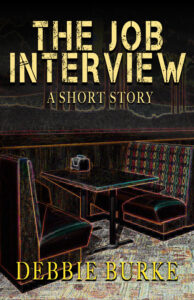by Debbie Burke
Good morning and welcome to the first page submission from another Brave Author who says the page is in the crime genre. Read and enjoy then we’ll discuss.
The Mark
Pink hair, tattooed hands, open casket. That’s all he remembered. Well, not quite all he remembered. He remembered his cell phone which he had forgotten to turn off, violating the sacred service with its demand for attention. Afterwards, standing at her gravesite, he looked skyward, muttered a few obscene words and prayed for forgiveness.
Hanagan sat and sipped the espresso. The wall mounted tv in the bar was showing early morning futures charts on the screen. Hanagan was a mid level options trader for a company called Maverick Trading. He’d had a good year trading other people’s money which was why he sat in this coffee bar waiting for someone named De Vries. The man had called him minutes ago, apologizing for his tardiness and promised he’d be there within 15 minutes.
Jensen De Vries had spent all night laboring on a 60 by 80 painting of an early 20th century abstract. Several shades of blue juxtaposed with bright iridescent streaks of red. Blackened blocks of burnt sienna guided the eyes to the hero marks that often identify the style of a painter. He moved his eyes back and forth from the canvas to a photo now projected onto his laptop screen. The photo of the twentieth century abstract that was last reported to be in a family estate somewhere in Portugal.
The coffee shop was not far from where De Vries painted. A rent controlled studio in a warehouse in Hell’s Kitchen. De Vries entered the bar and scanned the crowd looking for a bright blue blazer that would identify Hannagan.
He began to approach the man but hesitated. Another person had just sat down to join Hannagan. A woman he did not trust.
Earlier that day, in the suburbs of Greenwich, Connecticut,Maria De Vries stood in a darkened living room holding a gun. The room smelled like bleach, as if a crew had cleaned up any incriminating evidence. She turned towards the seated man and began to tell him what she was going to do and the order in which it had to be done. He didn’t like her patronizing tone, but kept his thoughts under control. He swiveled clockwise to a side table and selected a cigar from a humidor. He raised the cold cigar to his nose and inhaled the earthy aroma.
~~~
Let’s get to work.
Brave Author, your writing is solid and skillful. Your descriptions are vivid and full of excellent sensory detail. I can immediately visualize the body in the casket and hear the rude intrusion of a cell phone at a funeral. Iridescent red, blue, and burnt sienna are strong visuals. The smells of bleach and an unlit cigar are palpable.
Now the nitty gritty:
The first scene is in an unspecified cemetery and the point-of-view (POV) character isn’t identified. It’s in italics, indicating perhaps a preface.
The next scene switches to a coffee bar and an options trader named Hannagan (BTW, Hannagan is spelled two different ways) told through his POV. He’s waiting to meet an artist Jensen De Vries who’s late for their appointment.
Suddenly the location and POV switches to De Vries working on a painting in his studio in Hell’s Kitchen. He then heads for his appointment at the coffee bar with Hannagan but hesitates because he sees Hannagan with a woman he doesn’t trust.
Then the reader is yanked to earlier that day, in yet different location in Connecticut, with another new character, Maria De Vries, holding a gun on yet another new unnamed character who’s about to smoke a cigar and in whose POV we are now.
That’s SEVEN characters, FIVE location changes, and FOUR points of view in a single page.
This jumps around like a 30-second film trailer for an action movie that might have a title like Everything Everywhere All at Once.
Each scenario by itself could be compelling: a funeral; a mysterious meeting with a stranger; a woman who can’t be trusted; a woman (not sure if she’s the same woman) holding a gun at what may be a murder scene. Each one raises questions the reader wants answers to.
Yes, an author needs to instantly grab attention. But a precisely aimed bullseye is more effective than wildly scattered birdshot.
Trying to cram in too much information all at once overwhelms, confuses, and frustrates the reader. S/he feels whiplashed and never has a chance to become grounded in any single character, storyline, time period, or setting.
My strong suggestion is to pull back and look at the totality of your story. The connections among these scenes will undoubtedly be revealed later. Each has intriguing potential. But, as presented in this first page, they’re a discombobulated jumble.
Ask these questions:
- Which one of these characters is the most compelling?
- Which one of the conflicts makes the best launch point for this book?
- Which situation will make a reader the most curious to turn the page?
Assessments like this are difficult to make when an author is too close to the story. Don’t feel bad–we’ve all been there.
If you’re unsure how to answer the questions, find an editor, critique group, or beta reader to objectively review the book.
Listen to their feedback carefully. What scenario captures their attention the most? Which elements appeal to them and why? Then decide on the best time, place, space, and character to kick off the story.
When you rewrite the first scene, slow it way down. Give the reader a chance to explore that world, form an impression of the POV character, and become curious about the conflict/problem.
Your quick thumbnail character sketches are well done but too short. The descriptions are vivid and full of sensory detail. The situations are intriguing. Expand on them. You don’t need to rush so much. There’s a whole book ahead to add more plot lines, characters, and complications.
Brief, punchy scenes with jump cuts can be effective but not before the foundation has been established and the reader is firmly enmeshed in the story.
Brave Author, your skills are good, and you have all the necessary elements for an exciting crime story. I’m sure you’ll find the right beginning that fascinates readers so much that they’ll want to keep turning pages. Best of luck!
~~~
TKZers, what suggestions do you have for this Brave Author? Which of these scenarios strikes you as the best place to start?
~~~
 Please visit DebbieBurkeWriter.com to enter a drawing for a Legacy Wood Deep Fake Sapphire Pen (hand-crafted by Steve Hooley) and a BONUS FREE Short Story when you join my reading group.
Please visit DebbieBurkeWriter.com to enter a drawing for a Legacy Wood Deep Fake Sapphire Pen (hand-crafted by Steve Hooley) and a BONUS FREE Short Story when you join my reading group. 

Excellent advice, Debbie. I like the idea of opening with a funeral. It immediately raises story questions. Brave Writer, if you do start there, do NOT tell the reader why or how the person died. Instead, hint and tease and infuse emotion. They’ll wait to find out.
Thanks, Sue. Funerals are compelling. What are the effects on the people still living?
Teasing readers without confusing or frustrating them is a skill we writers need to practice.
Would I keep reading to find out more about a pink-haired, tattooed corpse? Oh yeah.
Excellent review, Debbie. Great advice.
There’s a lot going on in that first page. I agree with your advice. Each of those segments in different POVs could be developed into a fleshed-out scene and then included in the first chapter, separated by scene breaks.
You have an interesting story started, Brave Writer. Good luck with pulling it together.
Exactly, Steve. A “fleshed-out” first chapter with scene breaks can introduce the storylines and leave the reader wanting to turn the page to find out how they connect.
Brave Author, Debbie nails it. There is a lot going on but it is all half an inch deep. Pick a thread, let it lead. The funeral would be a great choice, and as Sue suggests, don’t spill how she died. Let’s find out.
Oh, why doesn’t he trust the woman? I didn’t see anything of recognition.
A half-inch deep is a great analogy, Alan.
Distrust of the woman is sort of interesting by itself but hinting at the reason behind his distrust really pulls the reader in.
Thank you, Brave Author, for submitting this piece. As others have mentioned, you have good writing skills, and I believe you can craft a riveting story. However, like Debbie said in her excellent critique, there’s just too much jumping around. Each one of the POV segments could serve as the opening of a different chapter, then weaving the threads together to form a coherent story.
“Pink hair, tattooed hands, open casket.” Great first line. I’d like to see you draw this paragraph out to an entire scene.
Kay, that first line grabbed me, too.
I agree-the funeral scene opener is a grabber. And it is mostly well-written.
But, after reading that, I spent most of my time trying to figure out where I was, who the characters were, and why I should care. I think our BA tried to cram all the backstory into the 400 word submission max . . . but here’s the thing: I’ve done that. We probably all have, right?
Debbie’s critique is spot-on and so are the comments so far. BA, you’ve got the germ of a great story here, one I’d turn the page on. Take Debbie’s comments to heart, and the rest of the TKZers’, and your story will shine. 🙂
Deb, the Brave Author should be encouraged by your comments. Thanks.
Debbie, I agree with your critique. I felt whiplashed, too.
Brave author, thanks for letting us take a peek at your first page. The character that intrigued me most was De Vries the painter. I already want to know why he is forging a painting? Who is paying him, or is he force to because of some kind of blackmail or threat to a loved one. (So obviously, that’s my vote for which character you should develop first.)
Priscilla, good observation about DeVries. An art forger offers lots of possibilities for a fascinating story.
May have a disappearing comment problem again.
This is from Gene Jennings:
Comment:
Agree with Debbie and others. Lots of jumping around. Had my head
spinning. But congrats to the Brave Author for stepping up to the
plate for a critique.
My only two cents (because I’m also an options trader) is that there
really is a trading company called Maverick Trading. Should
Hanagan/Hannagan’s company be fictional?
Thanks for adding that trading company name, Gene. Good idea to fictionalize.
Yes, anyone who puts their work our for people to read/critique is brave! Kudos for courage!
Thanks for finding my comment! Not sure what happened.